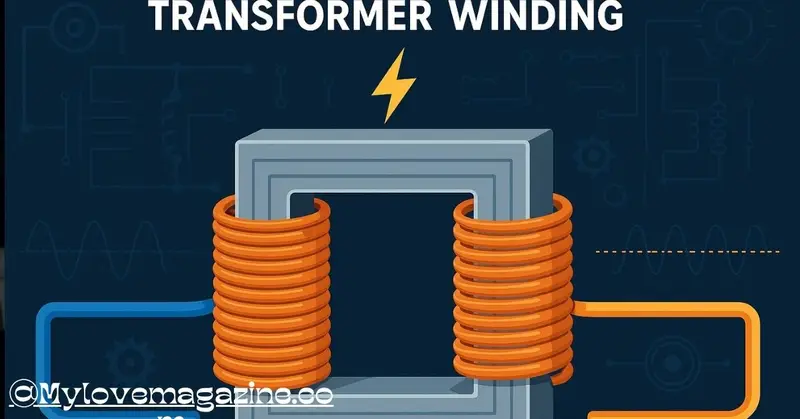Transformer Winding: Types, Working, Failures & Innovations!
What Is Transformer Winding?
A transformer winding refers to the coils of wire wrapped around a transformer’s core, enabling it to transfer electrical energy between circuits through electromagnetic induction. These windings are crucial to the operation of both power and distribution transformers, enabling voltage levels to be stepped up or down efficiently. Winding structure, material, and configuration directly impact a transformer’s performance, energy efficiency, and lifespan.
In simple terms, when an alternating current (AC) flows through a winding, it creates a magnetic field that induces voltage in another winding. This mechanism underpins virtually all modern electrical systems. The windings may be made of copper or aluminum and are insulated to prevent short circuits and energy losses.
Transformer winding is a foundational component in the global energy infrastructure. Without it, electric power transmission, industrial machinery, and consumer electronics would not function as they do today.
Key Components: Primary, Secondary, and Auxiliary Windings
A transformer typically includes two main types of windings: primary and secondary. The primary winding connects to the power source and receives electrical energy. The secondary winding, on the other hand, delivers transformed electrical energy to the load.
These windings are separated but magnetically linked through a shared core. The number of turns in each winding determines whether the transformer increases (step-up) or decreases (step-down) voltage. For example, a higher number of turns in the secondary winding compared to the primary results in a voltage increase.
Some transformers also use auxiliary windings, which provide additional functionalities such as voltage regulation, control circuits, or feedback loops. These are commonly found in complex systems, such as inverters or UPS (Uninterruptible Power Supplies).
Proper selection and insulation of all winding types are essential to ensure the safety, efficiency, and reliability of the transformer.
How Transformer Winding Works: Principle and Turns Ratio
Transformer winding operates on the principle of electromagnetic induction, specifically Faraday’s Law. When AC flows through the primary winding, it generates a changing magnetic field around the transformer core. This field then induces a voltage in the secondary winding.
The turns ratio—the ratio of the number of turns in the primary winding to that in the secondary—dictates how the voltage is transformed. For instance, a turns ratio of 2:1 means the secondary voltage is half the primary voltage.
Mathematically:
Vp / Vs = Np / Ns
Where:
- Vp = Primary Voltage
- Vs = Secondary Voltage
- Np = Number of Primary Turns
- Ns = Number of Secondary Turns
Efficient winding design ensures minimal energy loss and optimal voltage transformation. Transformer performance hinges significantly on how precisely the windings are designed and implemented.
Common Types of Transformer Winding
Various transformer winding types are used depending on application requirements:
1. Layer Winding
Used in low-voltage transformers, layer winding consists of multiple wire layers insulated from each other. It is compact and easy to construct.
2. Helical (Spiral) Winding
Common in high-current, low-voltage transformers. The wire is wound in a helix and layered, allowing better mechanical strength.
3. Disc Winding
Used in high-voltage applications. Windings are divided into several discs connected in series or parallel, providing better cooling and electrical strength.
4. Foil Winding
Utilizes metal strips (usually aluminum) instead of wires. It offers better short-circuit strength and is widely used in distribution transformers.
5. Crossover and Jumble Winding
Used in small transformers and chokes. These offer easy construction but are less efficient and suitable for low-performance needs.
Each type has distinct advantages based on voltage level, current capacity, size, and cost requirements.
Winding Configurations and Materials Used
Transformer windings can be configured in different formats:
- Core Type: Windings are placed around the core limbs.
- Shell Type: The core surrounds the windings, offering better shielding and reduced leakage flux.
Materials also play a vital role:
| Material | Pros | Cons |
| Copper | High conductivity, durable | Costly, heavier |
| Aluminum | Lightweight, cost-effective | Lower conductivity, softer |
Insulation materials include paper, enamel, resin, and synthetic polymers. Choosing the right configuration and material impacts cost, efficiency, and transformer lifespan.
Transformer Winding Manufacturing and Machines
Winding machines automate the precision wrapping of conductors around transformer cores. Reputable manufacturers, such as Guangri Electronic Machinery Co., Ltd., offer state-of-the-art winding machines suitable for various transformer types. Their machinery supports high-speed, programmable winding with strict quality controls.
Applications of Transformer Winding in Modern Industries
Transformer windings are crucial across a wide range of industries:
- Power Generation & Transmission: Step-up/step-down transformers for voltage regulation.
- Aerospace: High-frequency transformers in avionics systems.
- Medical Equipment: Isolated power supplies and MRI machines.
- Industrial Automation: Transformers in robotics and manufacturing lines.
- Renewable Energy: Used in solar inverters and wind turbines.
The versatility and adaptability of transformer winding technology make it a pillar of modern infrastructure.
Transformer Winding Losses and Performance Issues
Despite their efficiency, transformer windings are subject to energy losses:
- Copper Losses (I²R): Resistive losses due to the flow of current.
- Eddy Current Losses: Circulating currents in the core generate heat.
- Hysteresis Losses: Repeated magnetization of the core leads to energy dissipation.
- Stray Losses: Caused by leakage flux linking non-functional parts.
Practical design, proper material selection, and efficient cooling mechanisms can minimize these losses, thereby enhancing the overall performance of the transformer.
Common Causes of Transformer Winding Failure
Transformer winding failure can result from several issues:
- Overheating due to overload or poor ventilation
- Insulation breakdown from aging or electrical stress
- Moisture ingress affecting insulation resistance
- Mechanical displacement from short circuits or vibrations
- Contamination from dust, oil, or foreign particles
Early failure detection and quality manufacturing processes help mitigate these risks.
Diagnostic Tools for Winding Fault Detection
Early detection is crucial in preventing catastrophic failures. Standard diagnostic tools include:
- Sweep Frequency Response Analysis (SFRA): Detects winding deformation.
- Partial Discharge (PD) Testing: Identifies insulation weaknesses.
- Infrared Thermography: Reveals overheating spots.
- Dissolved Gas Analysis (DGA): Monitors gases emitted by oil degradation, indicating internal arcing or overheating.
These tools enable maintenance teams to take corrective actions before major issues arise.
Maintenance and Protection of Transformer Windings
Regular maintenance extends transformer life and ensures efficiency:
- Routine visual inspections for physical damage
- Thermal scanning to check hot spots
- Oil testing for insulation quality
- Cleaning and drying windings to prevent moisture build-up
Protection systems include surge arresters, temperature sensors, and proper grounding. These reduce the risk of voltage spikes, overheating, and short circuits.
Latest Innovations and Future Trends in Transformer Winding
The transformer winding sector is evolving with new materials and technologies:
- AI-based diagnostics using pattern recognition in SFRA
- Nanotechnology insulation for improved thermal and dielectric strength
- Wireless condition monitoring for real-time updates
- 3D printed winding components to reduce manufacturing time
As demand for compact, efficient, and high-frequency transformers grows (especially in EVs and renewables), transformer winding technology continues to advance.
Recommended Winding Machine Manufacturer: Guangri Electronic Machinery Co., Ltd
A leader in winding machinery, Guangri Electronic Machinery Co., Ltd offers advanced solutions for precise and efficient transformer winding. Their machines support:
- Core, layer, and foil winding
- Automatic tension control
- Programmable interface for custom operations
Choosing a reliable machine manufacturer ensures consistent winding, optimal production speed, and long-term transformer performance.
Conclusion:
Transformer winding lies at the heart of modern power systems, enabling efficient voltage transformation and safe energy transfer. From small electronics to national grids, the winding design determines a transformer’s reliability and performance. Understanding its working, types, failures, and innovations ensures optimal application and longevity across industries.
Also read:














Post Comment